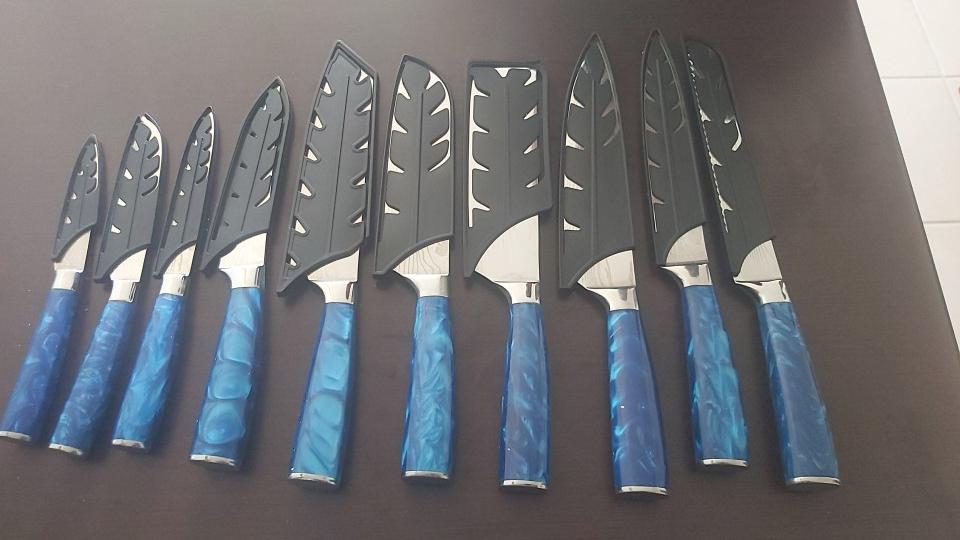Chef knife: The function of the chef's knife is mainly used for dicing, chopping and cutting. This kind of knife has a fulcrum, which allows your hand to swing back and forth to perform fast and continuous cutting movements. You usually need to use this kind of knife on a cutting board.

Meat cleaver: Meat cleaver is usually used to cut cooked meat or poultry into even slices
Paring knife: Paring knife is usually used to peel, cut, or trim some small ingredients that you just held in your hand when you were cooking, such as potatoes and apples.
Utility knife: Utility knife can be used for peeling, cutting and other purposes.
Serrated knife: As the name suggests, it requires a sawing action, which is quite suitable for processing bread, cakes, fruits and tomatoes. I prefer to use a sharp paring knife to process fruits and vegetables, but a knife with serrated edges is also suitable for peeling.
Boning knife: Boning knife always comes with a thick blade that can deal with joints of meat and poultry, whether the meat is raw or cooked. In addition, the boning knife can also be used to treat fish bones.
At present, most experts recognize that the most popular knives available on the market are high-quality high-carbon stainless steel knives. This kind of knife needs to be sharpened, but it will not rust and always looks shiny. This is because the carbon content of high-carbon stainless steel knives is lower than that of old carbon steel knives that are prone to rust, so they are harder and have a more durable edge. Although, in theory, high-carbon stainless steel knives can be sharpened like carbon steel knives, most people may not have enough knife skills to keep the blade sharp at home.
In addition, stainless steel knives do not leave the smell of food like carbon steel knives. However, most people's favorite knives are carbon steel knives that rust and show rust spots. Because carbon steel is softer than stainless steel, which means it is easier to be resharpened, most people can do it at home. However, because carbon steel is very soft and needs to be sharpened frequently, the edge of the knife is prone to deformation and distortion.
In addition, carbon steel knives are prone to rust, and the appearance is quickly not shiny and be stale, and it is easier to retain the taste of food than harder metals, allowing the taste of different ingredients to contaminate each other.

I used a carbon steel paring knife to make the fruits or potatoes sticky with garlic or onion flavor more than once, smeared with lemon slices, and then thoroughly cleaned and dried to remove these unpleasant odors.
The rust spots of carbon steel knives will not only remain on the rags but also on light-colored foods such as apples.
So if you have this kind of knife, be sure to wash and dry it carefully with your hands.
You can apply oil after drying the knife to protect it from rust, but remember to use oil that does not smell.
Carbon steel knives, like all other good knives, must not be cleaned in the dishwasher or soaked.
This cleaning method will make carbon steel knives blunter than other knives, the wooden handle will also be destroyed, and will be severely rusted after washing in the dishwasher.
The least ideal knives are those that claim to never have to be sharpened. These knives are very hard low-carbon stainless steel knives, which are not easy to become dull because they are too hard.
However, all knives will become dull one day, and you can only throw them away.
What's more, I didn't think this kind of knife is really sharp at the beginning, and the same is true for serrated knives which cannot be sharpened.
Good knives are usually forged and full-tang knives.
The handle and the blade body are integrally formed, and the internal and external materials are exactly the same. Forged blades are better than stamped ones because the way the metal molecules are arranged during the forging process makes the blade stronger.
The metal of a good knife will reach the very end of the handle. If you can see the tang in between from the gap of the handle, it is a so-called full-tang rather than a half-tang kitchen knife.
The handle should be fixed by riveting instead of glue. The handle of a good knife maybe wood or high-quality molded plastic. The wood has the best hand feel and is not as slippery, but high-quality materials can be guaranteed for a longer time.

Some people think that the wooden handle will have cracks and nicks after using it for a long time, which will easily hide dirt and breed bacteria.


0 comments